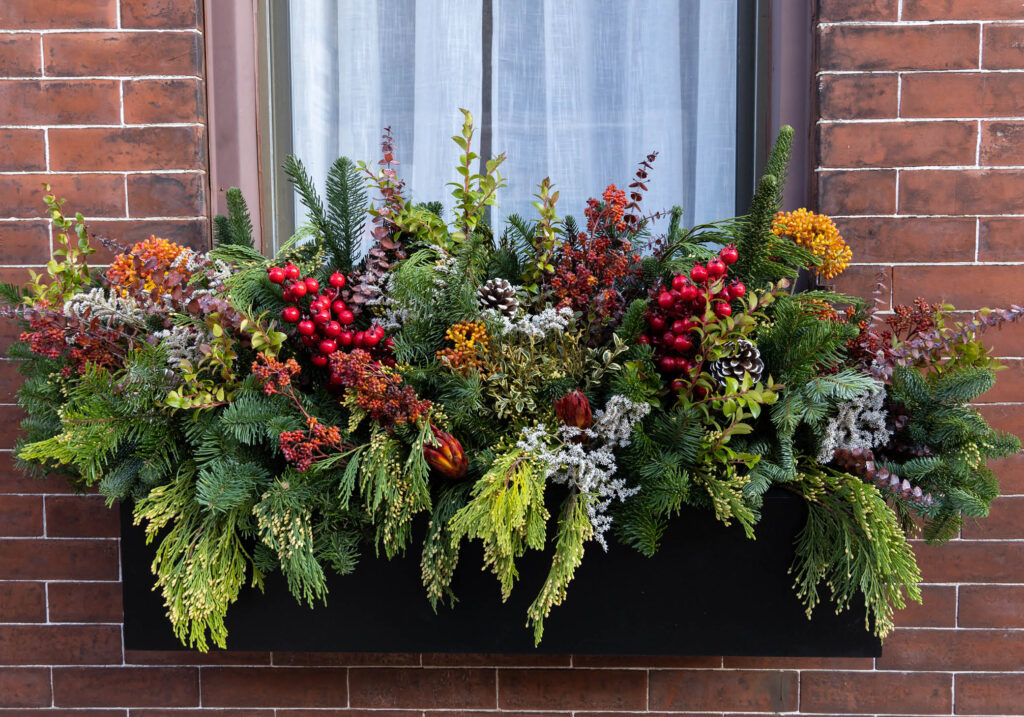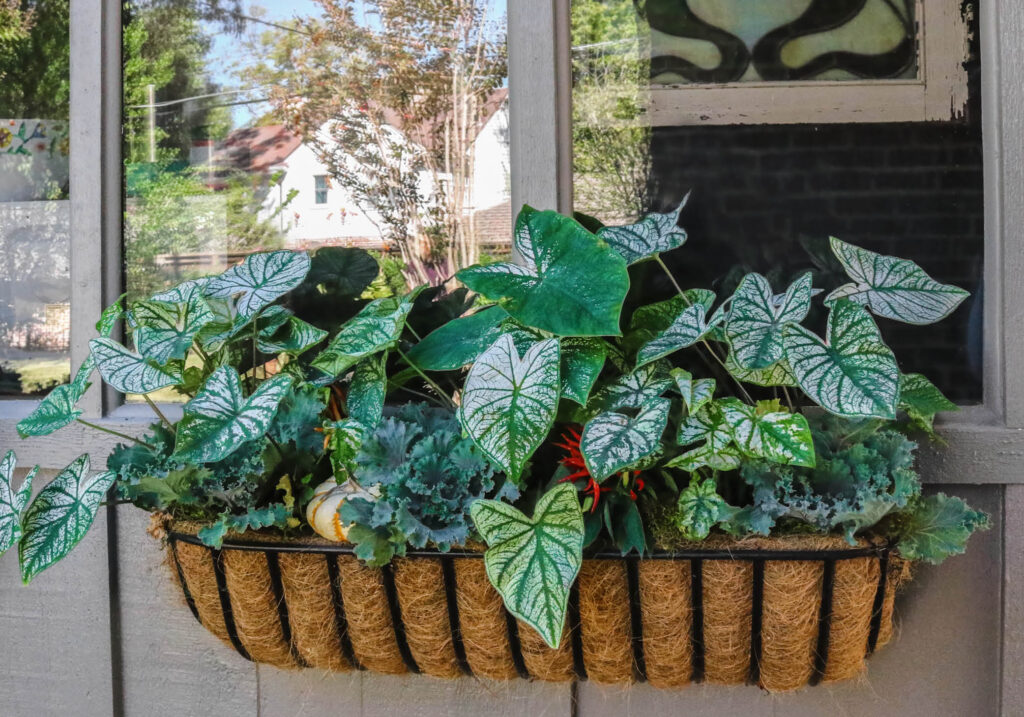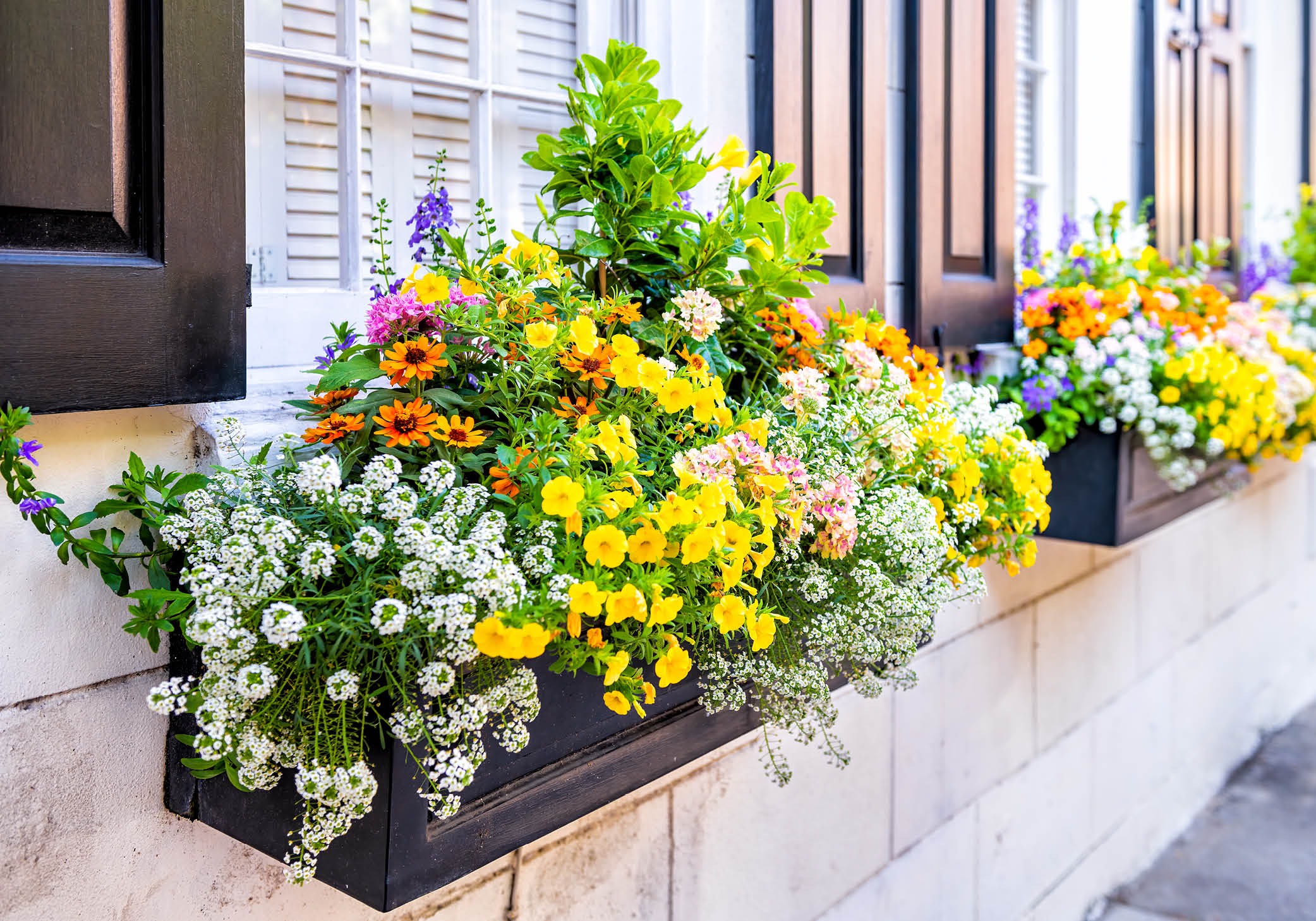Planting a window box filled with colorful blooms and greenery is a terrific, low-maintenance way to enhance your house’s exterior instantly. It’s also an appealing option for people living in condos or apartments without outdoor space who want to enjoy the benefits of a garden. If you are intrigued by the possibilities, read on as we reveal tips for designing and planting a lushly beautiful window box.

Choose the Right Window Box
Choosing the best window box for your needs is critical. Not only do you want it to fit your preferred space and look stylish, but you need to be able to hang it safely. Better Homes & Gardens cautions: “Don’t underestimate how heavy a window box can be—it is filled with soil and plants, and gets even heavier when watered.” The Magazine recommends a window box built from “a hardwood like redwood or cedar rather than pine, which rots quickly, and then securing the box with a window box bracket like the Panacea Holdall Flower Box Holder.”
If you are concerned that a wood box might be too heavy to hang from your window or balcony railing, Southern Living advises that “[you can significantly reduce weight by using fiberglass window boxes ….” Fiberglass is a good weather-resistant, affordable option for anyone who lives in areas that see significant rainfall or snow and has windows or railings that aren’t protected by a roof or awning.
Would you prefer a wrought iron option for your window box? While it does require a splurge, The Spruce loves the “H. Potter Copper and Wrought Iron Window Box.” This 30-inch window box has a higher price tag than many, “but rather than corrode, this 30-inch hand-crafted window box will only get better with time since it’s made from rust-resistant stainless steel and covered in a copper finish.” The wrought-iron frame is also weather-resistant, and the mounting and brackets make it easy to remove whenever necessary.
Check for Drainage
No matter which container you buy, it must have proper drainage so excess water can flow out of the box’s reservoir when it gets too full. If you have the tools and the know-how, drilling holes in wood or fiberglass products is a snap. If you don’t have the tools on hand or want a steel or ceramic planter option, consider purchasing a pre-drilled product.
You’ll also want to leave some space between the window box and the side of your house, condo, or apartment. How much room? Southern Living suggests leaving “at least 1/2-inch between the window box and the side of the house for water to drip through,” especially if the home is clad with wood siding.
Buy Potting Mix
When planting a window box or any container garden, you’ll want to buy potting mix rather than potting soil. The Spruce explains: “[Its] special combination of ingredients ensures that the mix retains moisture” and won’t compact around tender roots. Experts also believe that potting mix gives you more control over disease or weeds than you would have with soil.
Follow the Thriller-Filler-Spiller Rule
When mapping your window boxes, you want to create an arrangement of blooms and greenery that pops against the colors of your home. And all of your plantings should have similar sun, shade, and watering requirements; otherwise, you are likely to struggle to balance the needs of each of the plants. Martha Stewart Living recommends following the “thriller-filler-spiller” rule for anyone planting a window box. The design guideline “calls for a tall, striking plant (“thriller”) centered in the box and serving as the focal point; smaller, complementary plants (“filler”) on each side and the bottom; and plants that flow over the edges (“spiller”).”
Determine Your Growing Conditions
Will the plants in your window box have access to full sun (meaning more than six hours per day of direct sunlight), partial sun, or full shade? These growing conditions will profoundly impact which flowers, succulents, or vegetables will thrive after planting. If your site is particularly sunny, Martha Stewart Living suggests looking into “colorful flowering plants, like calibrachoas, a perennial that’s commonly seen in shades of violet, blue, pink, red, magenta, yellow, bronze, and white.” ‘Katrina’ African iris, which features “exotic flowers [that] top long, spiked leaves,” and ‘Sallyfun Deep Ocean’ salvia, which is known to be fragrant and a butterfly magnet, are among Better Homes & Gardens favorite full sun “thrillers.”
If you are planting a window box that will have partial sun, gardening expert Melinda Myers reports to Martha Stewart Living that “most petunias also do well in full to partial sun,” and “heliotrope has fragrant flowers that hummingbirds and butterflies love.” Myers is also a fan of pentas (as are butterflies) because it “blooms all season long and prefers full to partial sun.” Finally, Meyers loves “summer snapdragon, which (as its name implies) is perfect for the warm-weather season and features upright plants that are available in several colorways.”
Trailing lobelia is a great cascading option because while it thrives in full sun, it will still produce bold blue flowers (or purple, pink, or white, depending on which cultivar you plant) with partial shade. It’s an attractive option for planting below tall “thrillers.” Lotus vine, alyssum, verbenas, and plectranthus also offer significant spread for a beautiful cascading effect. Spiky cordyline is also not as finicky about sun exposure, with this “thriller” working with most soil types under full sun to partial shade conditions.
Container gardens and window boxes dry out faster than in-ground gardens. Depending on the materials window boxes are made of, the potting mix can be super-heated, particularly in areas that experience significant heatwaves. Drought-tolerant plants are often a better fit, especially in summer. Expert Melinda Myers suggests to Martha Stewart Living that dipladenia and zinnias are terrific options because they come in a variety of brilliant colors, “profusion and zahara have good disease resistance,” and “icicles licorice, also known as helichrysum, [is] a great heat- and drought-tolerant plant.”

Add Foliage
While flowers can take some time to become glorious, leafy greens immediately have a lush look. Martha Stewart Living recommends planting foliage in your window box as they “do a good job of providing a background to the showier plants that will be a planter’s focal point.” If you are stumped for which greenery to choose, the Magazine suggests coleus because while “it’s usually thought of as a shade-loving plant, coleus comes in varieties, such as Purple Prince, that do well in full sun.”
Plant by Season
If you live in an area of the United States that has dramatic shifts in temperature or experiences frost, Southern Living advises those planting a window box to grow blooms according to season. For example, the Magazine recommends planting “million bells [a colorful “filler”], lobelia, bacopa, twinspur, snapdragons, violas, nasturtiums, and flowering kale” for areas enjoying cool weather. When warm weather arrives, Southern Living suggests switching to “lantana, verbena, begonias, angelonia, impatiens, coleus, sweet potato vine, fanflower, narrowleaf zinnia, and Wave petunia” to beat the heat successfully.


